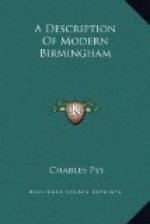Nearly at the top of the market-place, and fronting St. Martin’s church, a statue of this never-to-be-forgotten hero was exposed to public view, on the 25th of October, 1809; the day on which was celebrated the jubilee of our august sovereign George 3d. It was executed in bronze, by Westmacott, a statuary of the first eminence, at the expense of L2500, which was raised by voluntary subscription, to immortalize the memory of that much-lamented admiral. The attitude of the figure is expressive of that dignity and serenity with which the original was characterised, and the resemblance is upon the whole admitted to be more than usually correct. The circular pedestal whereon it is erected, is ornamented with figures in alto relievo, in a bold and masterly style, the limbs being so disposed, that except real violence is used, they are not liable to be injured. The relative proportion of the whole is admirable, and the general effect it produces gives the utmost satisfaction. As an artist, every praise is due to Mr. Westmacott, for the admirable skill he has displayed, and also for his unassuming conduct in presence of the committee, who had been appointed to superintend its execution.
On the scaffolding being removed, and the statue exhibited to public inspection, the following illustration of it was distributed by Mr. Westmacott:—
“In this work, intended to perpetuate the greatest example of naval genius, simplicity has been the chief object in the arrangement. The hero is represented in a reposed and dignified attitude, his left arm reclining upon an anchor: he appears in the costume of his native country, invested with the insignia of those honours by which his sovereign and distant princes distinguished him. To the right of the statue, the grand symbol of the naval profession is introduced. Victory, the constant attendant upon her favourite hero, embellishes the prow. To the left is disposed a sail, which being placed behind the statue, gives breadth to that view of the composition. Above the ship is a facsimile of the Flag Staff Truck of l’Orient, which was fished up by Sir Samuel Hood, the day following the battle of the Nile, and presented by him to Lord Nelson; the same being deposited at Mitford, as a trophy of that ever-memorable action. This group is surmounted upon a pedestal of statuary marble; a circular form having been selected, as best adapted to the situation. To personify that affectionate regard which caused the present patriotic tribute to be raised, the town of Birmingham is represented in a dejected attitude, murally crowned, mourning her loss; she being accompanied by groups of genii, or children, in allusion to the rising generation, who offer consolation to her, by producing the trident and the rudder.”
In front of the pedestal is the following inscription:—
THIS STATUE
IN HONOUR OF
ADMIRAL
LORD NELSON,
WAS ERECTED
BY THE
INHABITANTS OF BIRMINGHAM
A. D. MDCCCIX.




